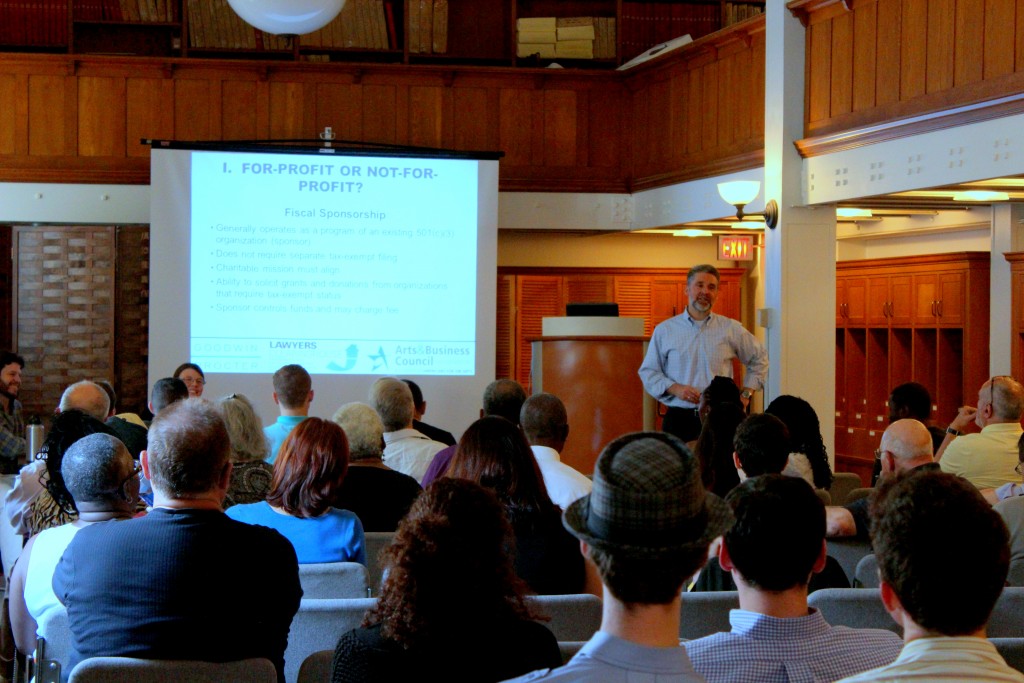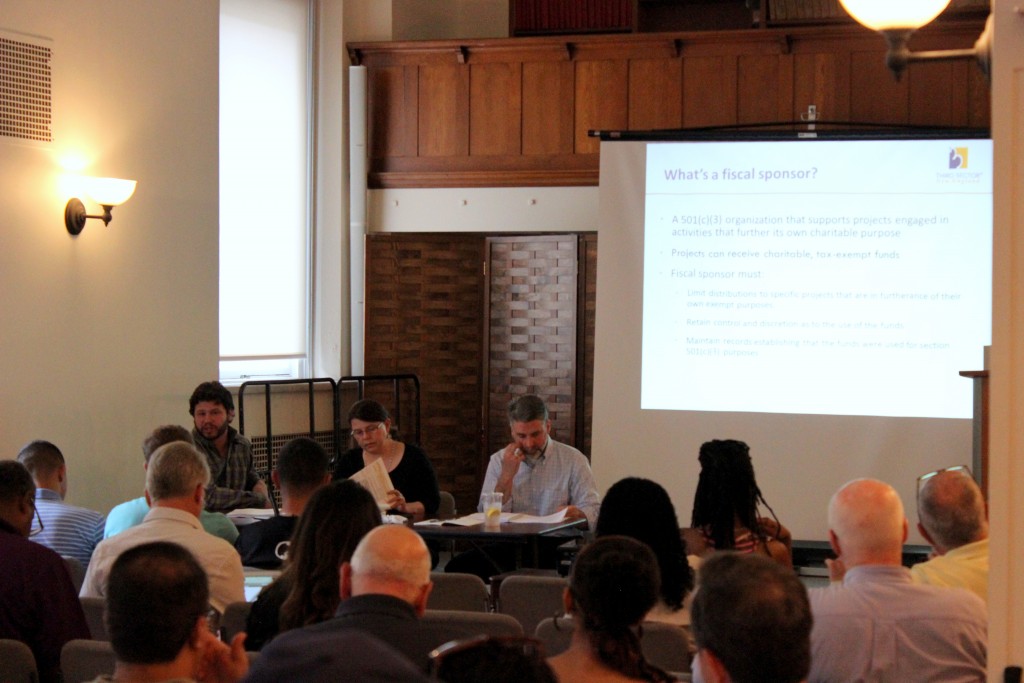
On May 12, the Lawyers Clearinghouse once again teamed up with the Boston Public Library to offer a free Nonprofit Incorporation Workshop.
Presenters Janet Rickershauser, Esq., of the Law Office of Janet M. Rickershauser; Jim Grace, Esq., of the Arts & Business Council of Greater Boston/Volunteer Lawyers for the Arts, who helped found the workshop series; and Joshua Sattely, Esq., of Third Sector New England walked attendees through concepts such as structuring a nonprofit, remaining in compliance with state and federal regulations, and the long-term documentation needed to effectively run and maintain a nonprofit in Massachusetts.
Recently, I contacted the three of them to learn more about their backgrounds as attorneys and to get their takes on starting a nonprofit and the state of the nonprofit sector as a whole. Below are their unedited responses.
Can you tell me what first inspired you to become a lawyer?
Janet Rickershauser: I went to law school as a second career, after a first career in academia. I wanted to do something that would give me more career options, and I also wanted to do something where thinking about issues and problems would lead to concrete, real-world solutions.
Jim Grace: I wanted to help people get access to legal services – especially those that could not afford it.
Josh Sattely: To be honest, it was kind of as a way to get my life together. I was way too immature for college and had been out of school a few years not really doing anything I was interested in doing for the long haul. However, I liked the problem solving aspects attorneys engage in and on a whim took the LSATs and did well so figured, why not? Not exactly inspirational and a terrible reason to take on the obscene amount of debt my legal education required but it is what it is.
How did you get into nonprofit law?
Janet Rickershauser: Early in law school I discovered that I have a knack for technical areas of the law, such as tax law. I’m a bit of a “lawyer’s lawyer.” Then I took a course on nonprofit law, with a really terrific professor. I had a feel for nonprofit organizations because of my university background, and through this course I learned that there are all kinds of interesting legal issues associated with nonprofits. Around that time the IRS issued a tax ruling which (through some rather dry, technical reasoning) had the result of enabling a nonprofit to invest in innovative drugs to fight malaria. This was the kind of law I wanted to practice! Since then, I have worked with Boston, New York, and Connecticut law firms with large nonprofit practices, and I am now starting my own practice to focus even more on nonprofit law.
Jim Grace: My first legal job was in a low income housing agency and I helped start a non profit as part of my job. When I moved to the Volunteer Lawyers for the Arts it became a big part of our services.
Josh Sattely: I took a nonprofit law class and helped a bike advocacy group get their c3 status and was hooked. Through helping that org I learned about fiscal sponsorship and got an externship with Third Sector New England and have been there ever since. Through this model, we’re directly responsible for the activities of 60+ charitable initiatives and hundreds of staff so there’s never a dull moment and I’m honored to support such visionary leaders.

How did you get involved in founding the series?
Jim Grace: We started the series to address the constant demand from folks interested in learning more about starting their own arts organizations. We wanted them to make informed decisions about non profits and to understand the process and the real challenges.
How did you become connected with the Clearinghouse’s Incorporation series?
Janet Rickershauser: I worked for about eight years with Goodwin Procter, a large Boston-based law firm with an extraordinary pro bono program. Through one of Goodwin’s pro bono initiatives, lawyers with experience in nonprofit law teach workshops sponsored by Lawyers Clearinghouse. I was invited to join this initiative shortly after I joined Goodwin. These workshops have been a wonderful opportunity for me to solidify my knowledge of nonprofit law — there is nothing like teaching to test what you think you know. It’s fun, too, to connect with people from all kinds of great organizations in the Boston area.
Josh Sattely: I’d been to a number of LC’s excellent seminars and asked Machiko if they ever wanted to do one on fiscal sponsorship. I learned they already cover it at the incorporation workshop and she invited me to join the panel to give fiscal sponsorship a slightly deeper treatment.
In your experience, what are some of the common misperceptions people have about starting a nonprofit?
Janet Rickershauser: People often don’t realize how much nonprofits are regulated. Founders are usually focused on their vision and not on the fact that their project will operate in the public sphere and ultimately belong to the public. Nonprofits are regulated, by the states in which they operate and by the IRS, to protect the public interest. The result is a lot of restrictions, filings, and other requirements that are very different from the for-profit world.
Another common misperception cuts in the opposite direction. Even if its purpose is not to make a profit, a nonprofit organization has to operate in the black like any other business. No matter how innovative or important a founder’s vision is, starting a nonprofit requires lining up financial support, usually in the form of contributions, but sometimes also through fees, ticket sales and other revenue. Nonprofit startups that end up being successful have a strong business plan to support the founder’s vision.
Jim Grace: How much time it takes to administer the organization and how much fundraising they will need to do to create a sustainable organization.
Josh Sattely: So many but the big ones are: 1. Nonprofits are easy to start and maintain; 2. success in the private sector automatically makes you well qualified to run a nonprofit; and 3. because you have a great idea and strong fundraising plan your nonprofit will succeed in raising the funds it needs to effectively pursue its mission. The last one is a real pain point as competition is intense and many foundations and donors aren’t interested in funding groups before they have established a solid track record.
What (if anything) do you think is the most important issue facing the nonprofit sector today?
Janet Rickershauser: I see tremendous energy and commitment in the nonprofit sector. This is evident at every Lawyers Clearinghouse workshop — the participants have amazing ideas and lots of enthusiasm. The challenge I see is to enable nonprofit organizations to have the maximum impact. At one end of the nonprofit sector, large foundations hold a huge amount of money. Studies have shown that all this money would have a transformative impact — on the environment, on poverty, education and access to healthcare — if it were expended in a short period of time, yet the tax rules allow foundations to spend only a small portion of their assets every year. At the other end of the sector, small nonprofits built on innovative ideas struggle to succeed, just like for-profit startups, for lack of financial support or organizational strength. Some small nonprofits join up with larger organizations, as focused projects or through fiscal sponsorships, to achieve the impact the founders hope for, but others go it alone. The laws regulating nonprofit organizations can seem like an additional set of obstacles, but they can also help guide nonprofits to more transparent governance, more effective fundraising, and ultimately more success in furthering their mission. My goal in practicing nonprofit law is to help nonprofit organizations navigate the legal landscape to achieve greater impact, whatever their mission.
Jim Grace: The lack of capital available to address the larger systemic issues.
Josh Sattely: There is a plethora of important issues facing nonprofits from broken funding models to having to comply with an absurdly complex compliance regime but I think the #1 issue needing more attention is supporting the development of the next generation of nonprofit leaders as the boomers retire. I’m amazed at the energy and nimbleness of today’s young social entrepreneurs but they’ll need an immense amount of support as they take the reins from their predecessors.
Additionally, this new generation is increasingly agnostic about what sector they’re in so long as the outcome is social progress. I think that’s good for society and presents tremendous opportunities but we need to be mindful of the challenges this also presents. When managed right, the legal framework governing 501(c)(3) organizations remains the only organizational vehicle that ensures benefiting the public is always the first and foremost priority. I have so much gratitude for Lawyers Clearinghouse because they not only introduce and educate nonprofits on concepts that need to be on their radars but also connect hundreds of nonprofits to expert pro bono counsel to help them navigate and innovate in this ever increasingly complex environment.


